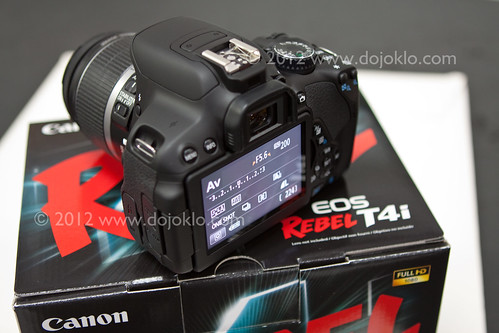Canon Rebel T4i / EOS 650D:
(After learning about the features of the new T4i here, see this other post for a comparison of the Canon Rebel T4i vs. EOS 60D)
Each year as Canon updates its high end Rebel (or xxxD) model, they borrow additional features from their more advanced (and more expensive) dSLR cameras, resulting in higher and higher quality consumer models that incorporate previous “pro” and “pro-sumer” features. The T2i then T3i added the improved 63 zone exposure metering system, 18 megapixel sensor, wireless controlled external flash, and full HD video of the pro-sumer models, plus threw in some additional menu items, custom function options, and in-camera processing features that were lacking in previous Rebels.

The Canon Rebel T4i / EOS 650D (image by the author)
Trickle-Down Features: The new Canon Rebel T4i / 650D demonstrates a significant leap in this “trickle-down” trend by taking the all-cross-type 9 point autofocus system and faster continuous shooting speed from the 60D and introducing these to the Rebel line. Although these previous omissions were seemingly necessary to differentiate the Rebels from the mid-level 50D/ 60D line, they resulted in two of the few but important “shortcomings” of the Rebels: they always had a less precise autofocus system with only one cross-type AF point (the center one), and a slower frames-per-second maximum continuous shooting speed. (Learn more about why cross-type points are so great just below.) Now with these improved features, the differences between the T4i and the mid-level 60D have been significantly reduced. (The 60D still offers additional external buttons and controls, slightly more rugged build and weatherproofing, and additional Custom Function options.)
All New LCD and Movie Focus: In addition, the T4i adds a first for a Canon dSLR: a touch-screen LCD that can be used for settings selection, image review, menu navigation, and even autofocusing or shutter release in Live View. Plus it offers a totally revamped hybrid autofocus system for Live View and Movie shooting that makes use of phase detection and contrast detect, allowing for another Canon dSLR first: continuous autofocus during Live View and Movie shooting. The phase detection aspect of the new AF system allows the camera to determine both the out-of-focus distance and the direction in which to correct, finally eliminating the slow and awkward focus hunting of previous models. Add one of the new “step motor” STM lenses such as the 18-135mm kit lens or the 40mm “pancake” and the lens will now silently focus during movie shooting, thus eliminating the autofocus motor noise previously picked up by the camera’s microphone. (Did I mention the built-in mic is now a stereo mic! And there is a stereo mic input jack.) Plus the image stabilization of the 18-135mm EF-S IS STM lens is designed to counteract camera shake caused by walking while shooting video.

Simulated view of the Canon T3i/ T4i viewfinder with 9 autofocus (AF) points. (Image by author)
All Cross-Type AF Points: Cross-type autofocus points are more accurate and more desired because they can grab focus on a wider range of subjects. If your non-cross-type point is oriented only in the vertical direction, and you aim it at a subject displaying a strong line also also in the vertical direction (such as the side of a door frame) it will not be able to detect the line or a change in contrast, and will not be able to focus. Aim it at the strong horizontal line of the top of the door, and it will lock right on. (learn more about autofocus concepts here.)
So the fact that the T4i uses cross-type AF sensors for all 9 AF points means that the autofocus system is significantly more accurate, and you can confidently use not just the center AF point but all the outer points as well to focus on or track a subject. Not to mention that the center AF point is now also an even more accurate diagonal cross-type sensor when using an f/2.8 lens.
Faster Frame Rate: The T4i now boasts a more rapid 5 frames per second maximum continuous shooting speed, and incorporates the speedy Digic 5 processor, narrowing another major difference with the mid-level 60D. These features will allow you to capture quicker shots in a burst thus giving you the greater possibility of capturing just the right moment of action or the best facial expression or pose.
As mentioned, the Canon T4i also finally brings us great quality touch-sensitive (not old-fashioned pressure-sensitive) touch-screen capabilities on a Canon dSLR (with smear-resistance!). You can select and change your settings on the Quick Control Screen (Q Screen) simply by touching your choice, or use it to tell the camera where to focus during Live View shooting. It can also be used to navigate the menus, and during image playback you can easily swipe and zoom with iPhone-like multi-touch motions and response. Early reports indicate that the screen responds incredibly well, and the graphic layout of icons and options make it easy to use. This 1 million pixel LCD screen is fully articulating, as with the T3i and 60D.
New Live View/ Movie AF Modes: So in addition to the upgraded AF system during stills shooting, Canon has modified the Live View and Movie Shooting autofocus system, which now offers Face Detection+Tracking, FlexiZone-Multi, and FlexiZone-Single AF modes rather than the previous Quick, Live, and Face AF Modes. Quick Mode AF is still also available for Live View shooting. (With Quick Mode you use the 9 auto focus points, similar to the viewfinder AF Points, as displayed on the LCD Monitor. But since the camera is using the autofocus sensor to focus, it momentarily interrupts the Live View on the LCD Monitor when it flips the mirror back down to access the AF sensor.)
All of these features contribute to the T4i / 650D being quite an amazing consumer level camera. In most ways it is a higher-quality, more capable camera that the pro-sumer 50D of just a few years ago, and it will definitely fulfill the needs and expectations of most any enthusiast shooter. The only reasons one would need to step up to the 60D would be if you need more direct access to controls, buttons, and settings on the body of the camera in order to change and adjust settings on the fly, if you needed a slightly more rugged and dust/water-proof body, and wanted greater ability to customize the controls and functions of the camera with its additional Custom Functions.
Borrowing from the 5D MkIII: The specs also note that due to the faster Digic 5 processor, the T4i has Lens Aberration Correction and Chromatic Aberration Correction features as first seen on the 5D3, as well as a new Ambient Light Correction.

Note the additional Mode Dial options and Power Switch change (Movie Shooting Mode) to the Canon T4i (image courtesy of Canon USA)
Some Extras: And in addition to the standard Creative Zone shooting modes (Av, Tv, P, M) and the Basic Zone modes (Flash Off, Creative Auto, Portrait, Landscape, Close-Up, Sports, Night Portrait) the T4i eliminates the Automatic Depth of Field mode on the dial and adds Night shooting without a tripod and HDR backlight compensation. Movie Shooting mode is removed from the Shooting Mode dial and is added to the On-Off switch. The T4i includes the Auto+ Shooting Mode (Scene Intelligent Auto) introduced on the T3i and even used on the 5D Mark III, where the camera analyzes the specific scene in order to automatically determine the best and most appropriate exposure, white balance, Picture Style, focus, and other settings.
The T4i shares the same battery (the LP-E8) and the same battery grip (the BG-E8) as the T3i and T2i. The fun filter (Creative Filters) effects introduced in the previous models (including Grainy Black and White, Soft Focus, Fish-eye Effect, Toy Camera Effect, Miniature Effect) are all still available, plus a couple new ones such as Water Painting and Art Bold.
Order your T4i from Amazon or B and H Photo today:
(If you plan to purchase the T4i, or any photo equipment or books etc., I encourage you to do so through these referral links. While your price will be the same, they will give me a little something for the referral, which helps to support my blog and my work – thanks! I appreciate your support!)
Canon T4i from Amazon – body only, 18-55mm kit, or new 18-135mm STM kit
Canon T4i from B&H Photo – body only, 18-55mm kit, or new 18-135mm STM kit


Remember to check out this other post for a comparison of the Canon Rebel T4i vs. EOS 60D.
For a full list of Rebel T4i / EOS 650D specifications and features, have a look here:
http://www.usa.canon.com/cusa/consumer/products/cameras/slr_cameras/eos_rebel_t4i_18_135mm_is_stm_lens_kit#Specifications







